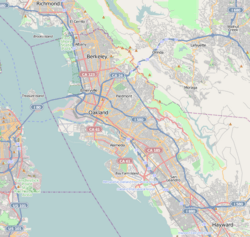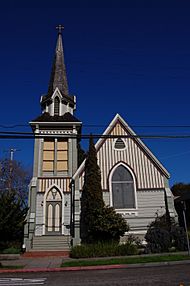Episcopal Church of the Good Shepherd (Berkeley, California) facts for kids
|
Church of the Good Shepherd-Episcopal
|
|
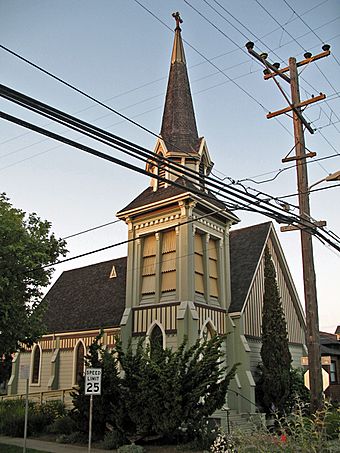 |
|
| Location | 1001 Hearst St. at Ninth St., Berkeley, California |
|---|---|
| Area | less than one acre |
| Built | 1878 |
| Architect | architect: Charles L. Bugbee; builder: G. W. French |
| Architectural style | Gothic, Victorian Carpenter Gothic |
| NRHP reference No. | 86003361 |
Quick facts for kids Significant dates |
|
| Added to NRHP | December 1, 1986 |
The Episcopal Church of the Good Shepherd is a historic church in Berkeley, California. It is well-known for its special wooden design, called the Carpenter Gothic style. This style was popular in the 1800s and used wood to create fancy details that looked like stone castles and cathedrals from Europe.
Built in 1878, this church is an important piece of Berkeley's history. Because of its unique design and historical value, it is protected as a city landmark and is also on the National Register of Historic Places, a list of the most important historical sites in the United States.
History and Design
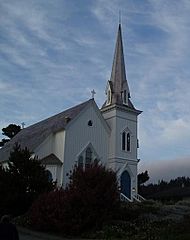
The church was designed by an architect named Charles L. Bugbee. He worked with his father, Samuel C. Bugbee, at their architecture company in San Francisco.
Inspired by Another Church
Charles Bugbee based his design on another church his company had created in 1867: the Mendocino Presbyterian Church. Both churches share the Carpenter Gothic style, but they have some key differences.
For example, the Mendocino church is covered entirely in a type of wooden siding called board and batten. This siding uses wide vertical boards with thin strips covering the gaps. The Church of the Good Shepherd uses this style only on its upper walls. The lower walls have a different siding called Dutch lap weatherboarding, where the boards overlap each other.
Special Features
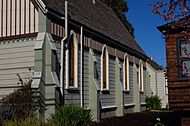
The Church of the Good Shepherd is considered more decorative than the Mendocino church it was based on. It has several eye-catching features:
- A tall bell tower located at the side entrance.
- A steep, triangular roof, known as a gabled roof.
- Tall, narrow windows with pointed arches, called lancet windows. These are common in Gothic architecture.
- Ornamental wooden supports on the outside walls called buttresses.
These details make the church a playful and beautiful example of the Carpenter Gothic style.
The Church Today
The Episcopal Church of the Good Shepherd is still an active church. It is part of the Episcopal Diocese of California. People in the community can attend services and events there.
On December 15, 1975, it became the second building in Berkeley to be named a city landmark. Later, on December 1, 1986, it was officially added to the National Register of Historic Places.


